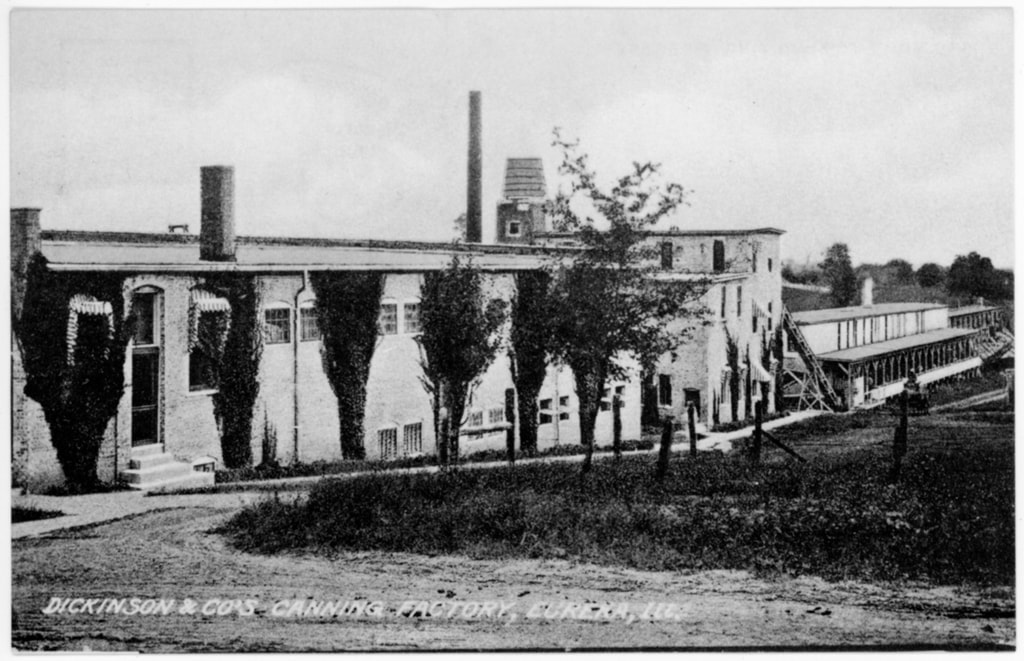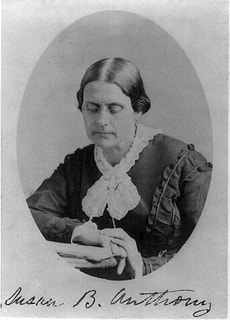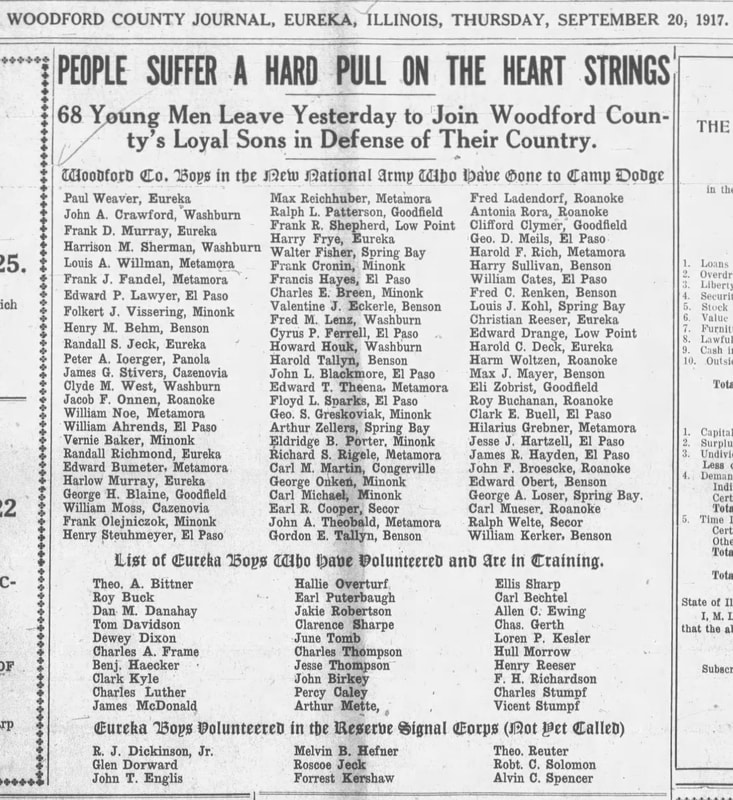|
Color film of portions of the 1947 and 1949 Eureka Pumpkin Festivals has recently been digitized and uploaded to YouTube. The film, shot by Glenn V. Sherwood, Sr. (1892 – 1956), was digitized by his son Glenn Jr. of Longmont, Colorado. Glenn Jr. contacted the Eureka Public Library about the film and granted permission to the library to share the YouTube link. YouTube link to Eureka Pumpkin Festival film: https://www.youtube.com/watch?v=0smOAtaW0R0 In 2015 and 2016, the library digitized over 300 Eureka Pumpkin Festival objects, booklets, and photographs and created an online archive of the festival (http://www.idaillinois.org/digital/collection/p16614coll19/search/). The project was funded by an Illinois State Library Digital Imaging grant. The Eureka Pumpkin Festival was a two-day community event held between 1939 and 1961. It drew tens of thousands of visitors to Eureka. A highpoint was 1947 when Eureka College alumnus and actor Ronald Reagan participated. Approximately 100,000 people attended that year’s festival. Until now, only black-and-white photographs of Reagan at the festival have been shared with the library. The film is so interesting because it is in color and to my knowledge is the only existing film of Reagan’s 1947 visit to Eureka. The film actually contains portions of the 1947 and 1949 festivals, which were spliced together into a 12-minute film. Although the segments are not in chronological order, overall the color film brings the festivals to life more than the black-and-white images which make up most of our online Eureka Pumpkin Festival digital archive. Actor and Eureka College alum Ronald Reagan participating in the 1947 Eureka Pumpkin Festival parade on horseback. This image is from Sherwood’s 1947 film. The film shows a pumpkin field, the canning factory, the different banners and signs decorating the town, a high pole act by the Aerial Snyders, Illinois Governor Dwight Green and Ronald Reagan at the coronation of Queen Joan Snyder, and the parades featuring Reagan on horseback and many, many colorful floats. With regard to the parade and crowds, Reagan was quoted as saying “This is the most amazing thing I’ve ever seen! The Eureka I knew was never like this!” Ronald Reagan and Illinois Governor Dwight H. Green participating in the coronation of Eureka Pumpkin Festival Queen Joan Snyder in 1947. This image is from Sherwood’s 1947 film. Glenn Sherwood Sr. and his family lived in Eureka until 1953. Sherwood was a representative for the American Sisalcraft Corporation for Illinois and was a correspondent for Illinois Building News. Sherwood and his wife, Evelyn, chaperoned Eureka College fraternity dances during their time in Eureka. Evelyn was a member of the Eureka Woman’s Club. The family moved to Bloomington in 1953. Glenn V. and Evelyn Sherwood at a Lambda Chi Alpha event in Eureka, ca. 1945 – 1953. Eureka Pumpkin Festival signs from 1947 (left) and 1949 (right). Images from Sherwood's film.
Pumpkins are the harbinger of fall in Illinois. Not only do the gloriously orange fruits decorate our homes and businesses, but we look forward to the aroma and taste of pumpkin pie at Thanksgiving dinner. Pumpkin is also Illinois’ official state pie! The history of canning pumpkins goes back over 100 years in central Illinois. It all began here in Eureka in 1902 when the Dickinson and Company canning factory made a small experimental pack of canned pumpkin. The company, which had been established in 1898, already packed corn, beans, and tomatoes. However, wishing to extend the canning season, they decided to try adding pumpkin to the roster. It was a success. Dickinson and Company continued to expand their business holdings, adding a plant in Washington in 1909 and Morton in 1925.
August 2020 marks the 100th anniversary of the 19th Amendment! Women fought long and hard for equal suffrage. In Illinois, the fight began in the mid-nineteenth century with the first suffrage meeting held in 1858 and the formation of the Illinois Woman Suffrage Association in 1869.
Eureka’s embrace of women’s equality dates to the mid-nineteenth century. Walnut Grove Seminary (forerunner of Eureka College) in 1848 was the third school in the nation and first school in the state to enroll women on an equal basis. In addition, there was an equitable number of women on the school faculty during the mid-nineteenth century. Eureka College further supported public discussion of equality by hosting Susan B. Anthony on campus in March of 1870 as she conducted a speaking tour across the state on women’s suffrage. We're celebrating the 90th birthday of our beloved library today with a walk down memory lane!
As early as 1888 the Ladies Literary and Social Club saw a need for a public library in Eureka. The club, which was formed in 1887, had 39 members and included many familiar surnames such as Allen, Callender, Crawford, Darst, Davidson, Dickinson, Johann, Major, Meek, Pifer, and Radford. The women contributed $1 each to buy books to form a library. However, their motion was tabled as there was no place for the library to be housed. In 1897 the organization was renamed the Eureka Woman’s Club. It was not until 1930 that the club signed a two-year lease for a building in the 100 block of South Main Street. In the April 10 edition of the Woodford County Journal, the club made their announcement of the coming library. In the midst of our own pandemic experience, I was curious to look back and see how Eureka fared in 1918 when the Spanish Influenza struck our town. Using digitized issues of the Woodford County Journal [hereafter referred to as the Journal] and the Pantagraph, this blog pieces together what was reported for the Eureka community. You can access the historical archives of both newspapers for free through Newspapers.com on the library’s public computers when we are open. For a firsthand account, please see 1918 influenza survivor Anna McCloud’s story which was recently published in the Peoria Journal Star: https://www.pjstar.com/news/20200411/luciano-eureka-woman-already-survived-viral-pandemic---more-than-century-ago.
In 1918 we were in the midst of World War I. The Journal regularly featured overseas news, letters from soldiers, and reports on local war efforts such as gasless Sundays, reducing waste, and donating nut shells and fruit pits for the manufacture of carbon for gas mask respirators. There was regular mention of pneumonia as a cause of death throughout the winter of 1917 – 1918, but it does not seem to be connected to any widespread pandemic. There was a report in the February 7 edition of the Journal of the death of Eureka soldier Henry William Jennings at the Great Lakes Naval Training Station Hospital of pneumonia on February 6. The Pantagraph noted the increase of pneumonia in the national army on March 29, 1918, and in July word spread of the influenza impacting the German army. The influenza gained widespread public attention in the fall of 1918 as it spread through the United States’ military camps. On August 17, 1918, the Pantagraph first used the term “Spanish Influenza” and reported that the New York City Department of Health warned against kissing “except thru a handkerchief.” The Journal, a weekly paper printed every Thursday as it is today, mentioned a relative of a Eureka family ill with pneumonia at Camp Custer, Michigan, on August 22. Throughout September, the Pantagraph continued to report daily on the number of cases quickly growing throughout the nation at both military camps and in cities. Of particular interest was the status of the Great Lakes Naval Training Station north of Chicago and Camp Grant in Rockford as many area soldiers were stationed there. On September 23 the paper reported that the influenza appeared at Great Lakes on September 9, peaked around September 19, and was now decreasing. September was also reportedly the coldest September on record. By late September and early October, the influenza was spreading rapidly through central Illinois. On October 1, the Pantagraph reported an outbreak in the town of Forrest in McLean County. At that time Forrest had 250 cases, three dead, and their schools and public places were closed. On October 5, Peoria reportedly had 22 cases. On October 7, Bloomington had 47 cases and Normal had 4 cases. On October 8 the Pantagraph printed a directive from the United States Surgeon General recommending all schools, places of amusement, and public meetings discontinued “in all places where the malady becomes prevalent.” Turning to Eureka, the September 27 issue of the Journal makes no mention of the influenza. Unfortunately, there is a gap in our knowledge of what happened the next week as the October 3, 1918, edition has not been microfilmed or digitized. The next available edition is the following Thursday, October 10. By then, the pandemic was the leading headline as residents were beginning to succumb: “R. P. Brubaker and W. H. Rosborough Die of Pneumonia” and “Influenza Epidemic Causing Much Alarm.” When the United States declared war on April 6, 1917, Eureka men were eager to volunteer. In the April 12 edition of the Woodford County Journal it was reported that 14 had enlisted or were expected to enlist. By the following Thursday an additional 10 men had enlisted. Many of the new soldiers were initially stationed in Peoria for training. On May 11 the Daughters of Veterans organization hosted a celebration in their honor with a band and a crowd welcoming the soldiers’ arrival on the train, games on the college athletic field, a dinner on the first floor of the courthouse, and a program in the courtroom featuring a Civil War veteran and patriotic music.
On June 5 all men between the ages of 21 and 31 were required to register for the war effort. Approximately 183 men from Olio and Cruger townships registered. Each man was assigned a number and on July 20, 1917, a nationwide drawing of numbers was held. The numbers were telephoned to the Woodford County Journal office and posted on the windows. Men and their families crowded the windows all day to see whose numbers were drawn. The numbers and names were published in the newspaper the following week. Woodford County was expected to fill a quota of 171 men, and in mid-August the County Exemption Board started examining the first 350 men whose numbers were called. By early September the full quota of 171 men was filled after a second round of examinations. |
AuthorLibrarian Cindy O'Neill loves researching local history! She has extensive experience in historical research, genealogy, and archival resource management. She previously worked in the archaeology and museum fields and has Master's degrees in both history and library science. Recent local history projects include a history of the Eureka Pumpkin Festival, the creation of a digital archive of festival photos and memorabilia on the Illinois Digital Archives website, and an architectural history of the Eureka Christian Church (Disciples of Christ). Archives
January 2021
Categories |












 RSS Feed
RSS Feed